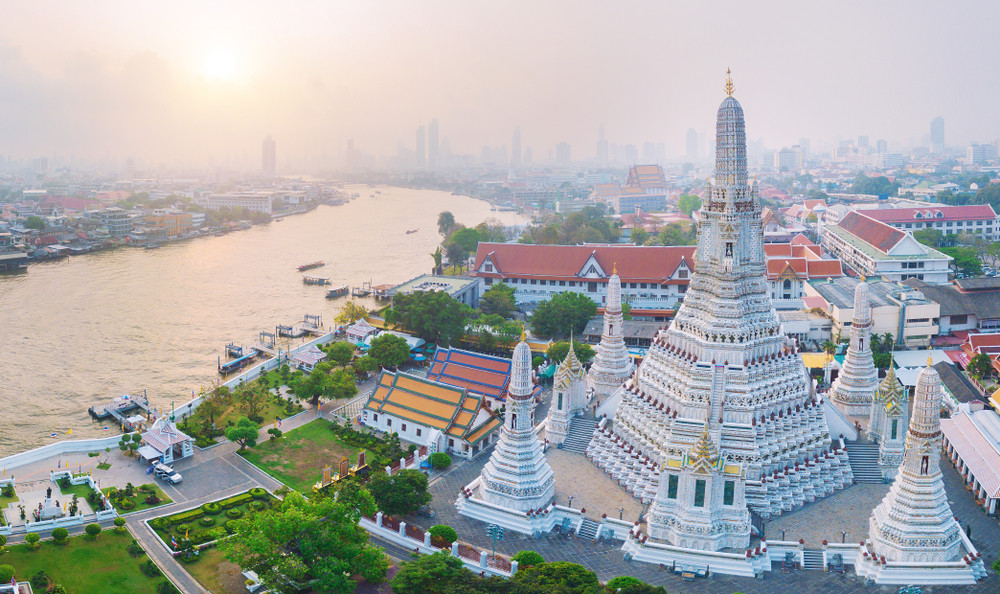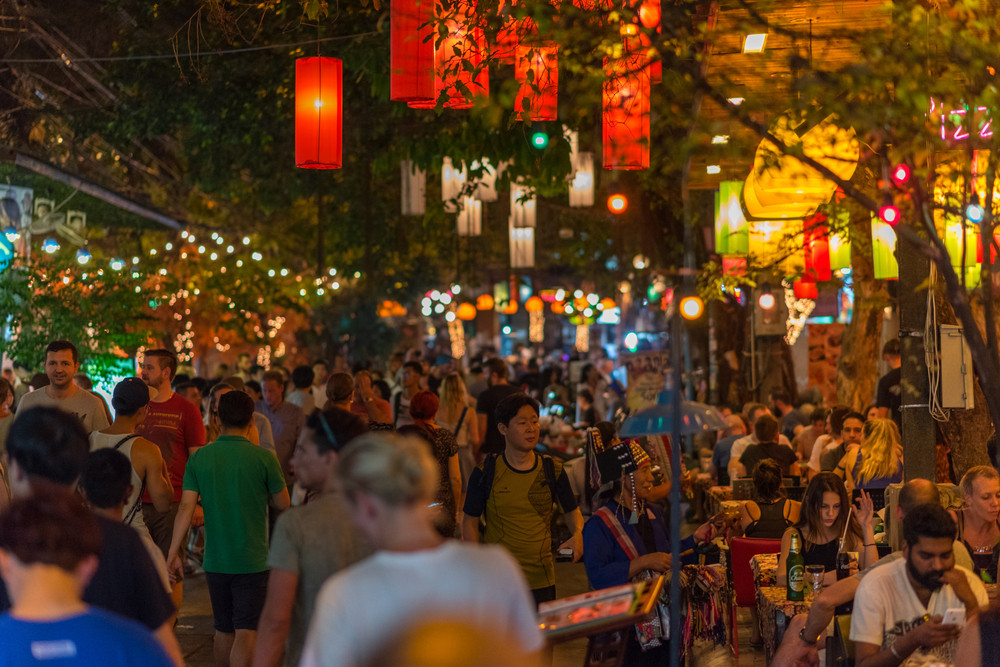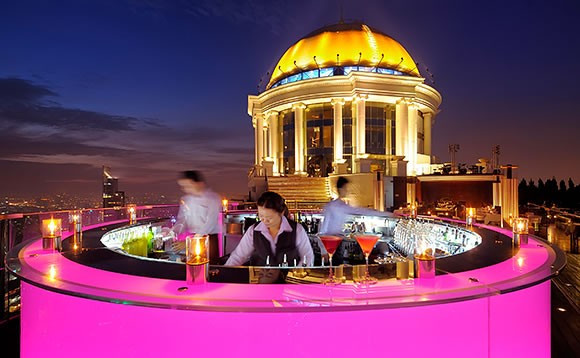With a myriad of cultural gems and a famously dynamic and diverse nightlife, Bangkok is a city where you can choose your own adventure. Travel experts Caroline and Phil are united in agreeing that Bangkok is one of the world’s great tourist cities, but their reasons for loving it are very different. Here are their individual perspectives on what makes it such a special city.
Phil: I thought Bangkok was going to be like The Hangover Part II, and then I fell in love with its temples and history.
I’m not trying to come across as elitist, but when it comes to city breaks, I want a location that’s steeped in history and dotted with cultural gems. I want world-class museums and beautiful architecture. Given that my concept of Bangkok had largely been formed by 2011 bro comedy The Hangover Part II, I did not have high hopes for my time in the Thai capital.
It took me, perhaps, a day after we touched down at Suvarnabhumi Airport to realize I was staggeringly wrong.
Stirring after a dreadful night’s sleep – prompted in part by jet lag and by the incessant intertwined basslines of Khao San Road – Caroline and I set off on foot to see the sights of Bangkok’s old town, Rattanakosin. The heavens opened periodically; we’d arrived at the tail end of the rainy season. Leaving our hotel, we waded through murky ankle-deep water, fighting off the attentions of tuk-tuk drivers insistent that walking anywhere in this weather was “crazy.” An inauspicious beginning. But I was won over the second we stepped into Tha Phra Chan Amulet Market.
Tha Phra Chan Amulet Market
The dense riverside warren of covered stalls took me completely by surprise; it was more Middle Eastern bazaar than backpacker-heavy party district. Avid Thai collectors – predominantly monks, taxi drivers, and those in dangerous professions – painstakingly trawl the endless displays, looking for the amulet most likely to bring them good fortune and protect them from harm. Some of the amulets sport elaborate, bejewelled Buddhist imagery, others carry messages inscribed on tiny tablets carved from plaster, wood, and bone. To Western eyes, there’s little to differentiate them. But to those in the know, some have untold value. Watching the eagle-eyed collectors flicking through vast folders of amulets and haggling over prices was all it took for me to fall in love with this frenetic city.
Of course, Bangkok’s cultural highlights aren’t limited to a few thousand amulets. The city may be most famous for its towering sky bars and relentless energy, but it’s also home to some of the region’s best museums and most ornate temples.
Catching the ferry from Tha Tien Pier across the Chao Phraya River, then dodging the hulking barges slowly hauling their cargo upstream, you edge closer to the imposing 82-meter spire – or prang – of Wat Arun, nicknamed the “Temple of the Dawn.” It’s unlike anything I’d ever seen before.
Wat Arun

From a distance, it dominates the skyline on the Chao Phraya’s western bank. Up close, it’s even more impressive. Every inch is covered with intricate multicolored floral mosaics crafted from Chinese porcelain, used as ballast by Chinese merchant vessels before being discarded on reaching the Thai capital. Unlike most Thai temples, you’re actively encouraged to climb Wat Arun. The views across the carob-colored river, still lined in places by weather-worn wooden shacks, are among the best in Bangkok.
For the most part, Thailand feels utterly Southeast Asian. In some ways, it feels more Asian than its neighbors – no coincidence, given that it was the only country in the region never to be colonized by Europeans. But that’s not to say the Western world hasn’t left its mark on Bangkok. One of the most remarkable examples is the Jim Thompson House, a museum that’s both exactly what you’d expect and nothing like you’d imagine.
Jim Thompson House
Yes, it’s a house that belonged to a man called Jim Thompson. But it looks utterly incongruous in the heart of modern Bangkok. Despite being just 1km from the gleaming shopping malls and criss-crossing flyovers of Siam Square, it feels like stepping into a jungle clearing; the old teakwood buildings are shaded by monkey pod trees and surrounded by verdant gardens.
The eponymous Jim Thompson, an American silk magnate and former CIA agent, built the house in its current location in 1959. Rather than erecting a contemporary mansion house, he chose instead to collect parts of various derelict Thai homes and have them rebuilt on the banks of the Saen Saep canal. Some were transported from the ancient royal capital of Ayutthaya, while others were pulled down from the neighborhood of Baan Krua, a historic hub of the silk-weaving industry, on the canal’s opposite bank. The museum offers guided tours of the airy main house, which is still complete with original features and artworks. It might be a cliche, but visiting the property is like stepping back in time to an age when Bangkok had yet to become an Asian megacity, when its tallest building had just nine storeys and water buffalo could still be spotted within the city limits.
To wrap it up:
There’s no doubt Bangkok loves to party. Whether you want chic cocktail bars, glamorous sky lounges, or grungy side-of-the-road watering holes, you’ll find it here. But you can only start to get a handle on this fast-paced, eclectic city once you shake off your hangover and set out to explore its cultural jewels.
Caroline: My favourite part of being in this irresistible, colourful city is people-watching with a Chang.
Every time I land at Suvarnabhumi Airport, I ask the taxi driver to take the highway into the center. Partially because it’s quicker than sitting for hours in the chronic, choking traffic that plagues the world’s eighth most congested city, but mainly for the electrifying thrill of seeing the Thai capital’s Gotham-esque skyline materialize through the windscreen.
Bangkok was my first enticing taste of Asia. Flying in at age 20 from industrial northern England, I couldn’t believe a city like this was permitted to exist: haphazard, chaotic, and sweltering. It seemed woven together by a very unfamiliar magic and I was hooked. In the 11 years since, I’ve travelled extensively around Southeast Asia and returned to Bangkok whenever I had the chance. After all, you never forget your first.
The Thai capital is home to a myriad of must-see landmarks, from the huge, glittering Grand Palace thronging with tourists, to tranquil Wat Pho, where the giant reclining Buddha radiates golden serenity. Yet for me, the seduction of Bangkok is in the rowdy markets in the frenzied street food restaurants where you can enjoy a $1 dinner of noodles against a backdrop of ritzy skyscrapers. It’s in the open-fronted bars that line narrow backstreets, booming pop hits, and karaoke, where revellers glug their way through Chang towers and luminous cocktails. It’s in the sharp contrasts and the people watching.
Khao San Road
The merits of Khao San Road, Bangkok’s neon backpacker district, are hotly debated amongst travellers. A short wander along this bar-lined street will see you aggressively presented with trays of scorpions on sticks and offensively-embroidered wristbands. You’ll be offered a “sexy dress” while men try to sell your partner ping pong shows and tuk-tuk drivers tend to call you “crazy” when you turn down a ride in their disco-lit vehicles. It’s seedy, it’s inauthentic, and cocktails are served in buckets. But if you leave any semblance of pretension behind, Khao San is a superb people watching spot. It’s just the people you’re watching will likely be drunk tourists in eye-watering “same same” vests.
Soi Rambuttri

Close by, lantern-strung Soi Rambuttri, a street that runs parallel to Khao San, is one of my favorite spots for a beer in Bangkok. Prettier and quieter than Khao San, but no less dynamic, it boasts a diversity of shops, bars, and restaurants. Here you can sip cocktails served from a flashing VW camper van or at a bar carpeted with sand, and eat delicious pad thai at street food stalls for 50c. Alternatively, head to the relatively upscale Alley Cat bar for wine and an unlikely international menu that includes mince pies. Around the corner is Bombay Blues, where waiters in boiler suits serve mouth-watering Indian food and jello shots. It’s still not ‘real’ Bangkok, but it is a lot of fun.
Sukhumvit

Want to leave the backpackers behind? Lose the elephant pants and direct your tuk-tuk to Sukhumvit: one of Bangkok’s major party districts. This thronging area is home to many nightclubs, with highlights including the hip Demo & Funky Villa, and 3 Levels where DJs spin a mix of musical genres. If you’re feeling brave, take a quick wander through Soi Cowboy: Bangkok’s notorious red light district. This area is peppered with go-go bars, and, while not somewhere you want to hang around long, is worth a look thanks to its bouncing carnival atmosphere.
Silom

Meanwhile, lively Silom offers a true diversity of nightlife. Here you’ll find high-end bars, such as the 1930s Cantonese-inspired Maggie Choo’s and the Sky Bar at the Lebua State Tower (famously featured in The Hangover Part II). These swanky night spots come with upscale dress codes, so pack with this in mind if this is your vibe. Back on street level, Silom Soi 4 and Soi 2 are the city’s vibrant gay districts. Soi 2 is the most intense of the pair, while a more diverse range of drinkers sit outside the buzzing bars of Soi 4 and watch events on the colorful street unfold as the sun descends behind the high rises.
To wrap it up:
Whether you’re exploring jaw-dropping temples, sipping a cocktail at a glittering sky bar, or simply stuck in a traffic jam, it’s clear that Bangkok is a city with an indomitable spirit. But to truly understand what makes this city so special, dedicate an afternoon to chilling in a local bar with a Chang in hand. I’m in my 30s now, but sitting on the street watching this spellbinding city go by inevitably transforms me back into that travel-naive 20-year-old, hopelessly drunk on Bangkok.
Want more?
Explore more of our favorite things to do in Thailand.